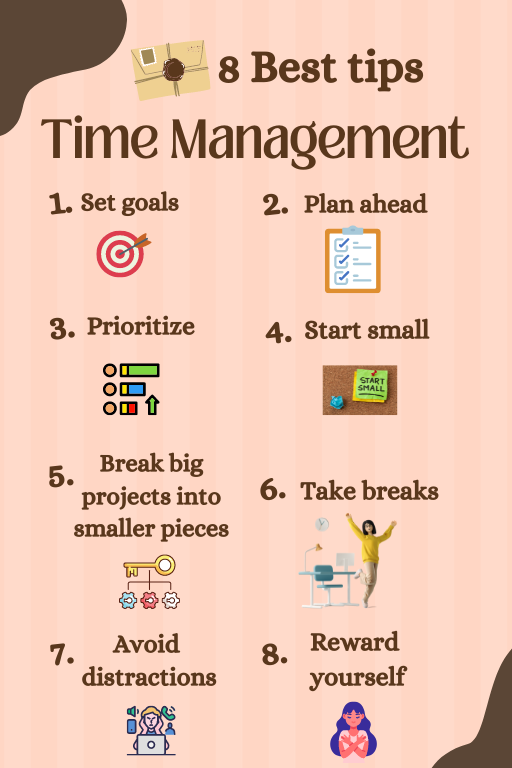|
Time management is a very important aspect of being a business owner. The secret to getting the most out of your time for your work and personal life– is you must learn to manage time. Managing time helps you to stay motivated and engaged in your career. Being great at managing your time will also mean you are not as stressed out, as you will have learned to only take on responsibility for things you actually need to get done. Having a plan is a huge help to keep your focus on your tasks and use your time wisely.
In this article, I will explore why time management for artists is essential, and leave some tips to implement time management so that you can see improvement in your performance and productivity. "Time is more valuable than money. You can get more money, but you cannot get more time." - Jim Rohn Why is Time Management for Artists essential?Many artists know how to create incredible artwork but may not know how to manage their time. They have so many responsibilities in addition to creating artwork. Despite popular belief, most artists spend a significant amount of their time managing the business of their art; whether it’s managing social media accounts, developing sales tools, cultivating and maintaining relationships with clients, developing public relations plans, or becoming familiar with and confident in the many channels available to the creative market. The time spent out of the studio is not lost time but rather a time for nurturing and developing the business of your art. Artists should strategically split their time to each side of their business so that they achieve their business goals and get a higher return on the time investments they make. That is to say, time management for artists is essential to improve art business performance and productivity. 8 Best Time management tips1. Set goals
The best thing you can do is set your goals, and keep track of what you’ve accomplished. You need to bring awareness to how you are spending your time so you can create a great time management plan and follow through with it. One solution is to take a few minutes every morning to brainstorm what you want to accomplish and add those goals to your calendar. You can list your goals in a word document.
Some examples of artistic goals are:
2. Plan ahead
Make a daily list of everything you’re going to get done today. This includes things like writing down tasks that need to get done, making lists of things that need to be completed, etc. You may want to be a little more detailed in this list (i.e. list the steps to accomplish the goal). Planning ahead helps you stay organized and avoid procrastination. If you notice you are off task you can look at your list to help you refocus
For example: To get more followers on social media some things on your list might be:
3. Prioritize
Prioritizing means deciding what is most important to accomplish first. When you have a lot going on, it’s hard to know where to start. But if you prioritize your tasks, you can focus on the most important ones first. It is always better for an artist to design/create art when he/she has high energy. In that case, first priority in that time has to be for art creation rather than other work. Knowing what to prioritize can be a challenge. You need to take into account all your tasks/goals, any pressing deadlines or obligations, etc.
Some people find that their brain is sharpest in the morning so it can be a good time to get some of the business side of things done, and then end your day with art creation. Other people prefer to set certain days aside for business tasks, and other days for creating. There is no one size fits all approach, but making sure to start with what is the highest priority is necessary for making sure you don’t miss out on good opportunities. 4. Start small
Start small. Don’t try to tackle everything at once. Instead, take one task at a time and complete This helps you keep your full focus on one task at a time. Remember you don’t have to accomplish everything overnight.
5. Break big projects into smaller pieces
Break more significant projects into smaller pieces. Take time to define exactly what the exact challenge is. I don’t mean to avoid it, but if you’re working on a project that’s beyond your skill level or it takes you so long to complete that it puts you in a rut, you can’t realistically expect to finish it within a short amount of time. If you’re working on a project requiring a lot of attention, break it into smaller parts. That way, you won’t feel overwhelmed and you’ll be able to finish the project sooner.
6. Take breaks
Take regular breaks throughout the day. Get up and move around every hour or two. Stretch your legs, drink some water, and clear your head. This can help to boost your mind and keep you energized throughout the day. This in turn helps to improve your performance in the work.
7. Avoid distractions
Many people spend their time on their computers and phone and listening to music, podcasts, and audiobooks. You may be constantly inundated by phone and computer notifications which are some of the biggest distractions. Utilize the automated systems on your phone so you don't have all of your work-related notifications on all the time. Learn to silence notifications when you really need to focus. If you have any notifications on your internet browser, disable them. Of course, some people enjoy listening to music, podcasts, or audiobooks while they are creating, but pay attention- what works while you’re creating may be a hindrance when you are checking emails or doing bookkeeping.
Digital notifications aren’t the only distraction though. It can be something as simple as that pile of laundry, or randomly wanting to chat with a friend. With many artists working from home studios, it is imperative that you value your work time and don’t fill it up with household chores and personal tasks. Flexibility in the schedule is a job perk, but respecting your work time (and expecting others to respect it) is a necessity. 8. Reward yourself
Reward yourself after completing a task. A reward doesn’t necessarily have to be materialistic; it could be anything that makes you happy. It also enhances your mind to do the next tasks and deliver the best results. Make sure to mentally acknowledge, or even write down, what you accomplished. Don’t just jump from one task to the next without acknowledging your hard work and accomplishments. People weren’t meant to live their lives by a constant checklist. Avoid burnout by celebrating what you accomplish.
Conclusion
Time management for artists is just as important as it is for any other professional.
It is rare for a person to achieve any success without a well-established plan and time management. Time management helps you to achieve your goals and reduce stress because your workflow is well organized and planned. Got time management tips? Share them in the comments. Useful Information for female artists:
0 Comments
Leave a Reply. |
Archives
March 2024
Categories
All
|


 RSS Feed
RSS Feed